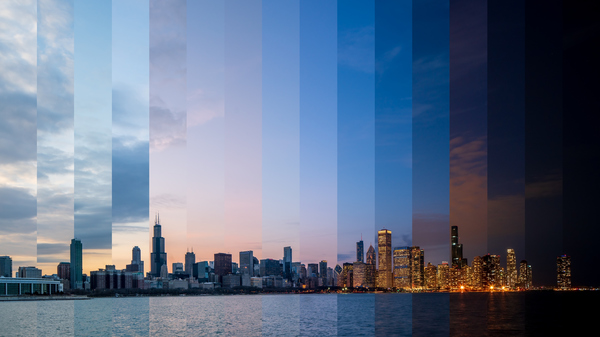Get Ready for the Equi…lux!
The September equinox is upon us. But did you know that day and night are equal on a different date? Find out why and when.

Day-to-night collage of the Chicago skyline.
©iStockphoto.com/Gian Lorenzo Ferretti Photography
Equinox Is Next Week
On Friday, September 23, at 01:03 UTC, the Sun will traverse the equator from north to south. This moment is called the September equinox.
Day and Night Won’t Be Equal
It’s often said that day and night are equal at the two equinoxes (there’s another one in March). After all, the term equinox translates from Latin as ‘equal night.’
However, if you look at the day lengths in your city, you will find that the time between sunrise and sunset is a little more than 12 hours on the day of the equinox. Find out why
The moment when day and night are actually equal falls on a different date. That date is called the equilux.
“The difference in day length between the equinox and equilux is only a matter of minutes—it’s not something we tend to notice,” says Graham Jones, timeanddate’s resident astrophysicist.
“Having said that, the difference is real, and it’s fascinating to see it show up in our sunrise and sunset data.”
Equilux Is Today (But Not Everywhere)
So, when is the equilux? Well, the date depends on where you live.
In the Southern Hemisphere, the equilux happens a few days before the September equinox; for Northern Hemisphere dwellers, it is a few days after the equinox.
For example, people in central and northern Europe will experience equal day and night on September 25; New Yorkers on September 26.
Find Your Equilux Date
The table in our equilux article gives a rough overview of the equilux dates at different latitudes—but it’s also possible to find the exact date for your location:
- Go to our Sun Calculator and search your city.
- Scroll down to the table and find the date when the duration shown in the ‘Length’ column is closest to 12:00:00.
Example: The Equilux in Los Angeles
Day lengths in Los Angeles:
- September 24: 12:04:05 (4 minutes and 5 seconds longer than 12 hours)
- September 25: 12:01:59 (1 minute and 59 seconds longer than 12 hours)
- September 26: 11:59:53 (only 7 seconds shorter than 12 hours)
- September 27: 11:57:47 (1 minute and 59 seconds shorter than 12 hours)
On September 26, the day length is closest to 12 hours. This means that the equilux in Los Angeles happens on that day.